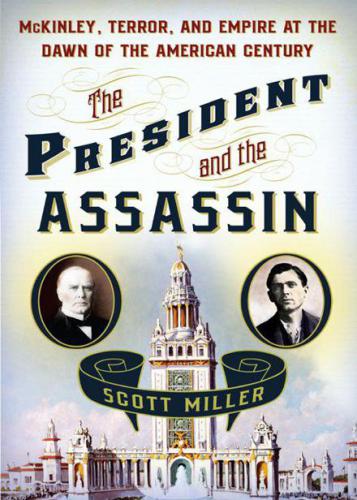
The President and the Assassin
McKinley, Terror, and Empire at the Dawn of the American Century
کتاب های مرتبط
- اطلاعات
- نقد و بررسی
- دیدگاه کاربران
نقد و بررسی

April 4, 2011
Miller, a correspondent for the Wall Street Journal and Reuters, faithfully captures the turbulent time at the turn of the 20th century when America faced discord from within and without, and war and an assassin altered America's history. President McKinley, then the most popular U.S. president since Lincoln, rose from humble beginnings in Ohio to become a Civil War hero and hardworking congressman, and as president determined to govern with a nonconfrontational style and maintain a peaceful foreign policy. In telling the stories of McKinley and his killer in alternating chapters, Miller uses sharp parallels between the president and his anarchist killer, Leon Czolgosz, a factory worker who lost his job in the crash of 1893 and was something of a loner who found an emotional outlet following the anarchist movement and activist Emma Goldman. Goldman's words inspired the depressed man to violence. With a smoldering labor crisis, foreign woes with Spain and Cuba, and a harsh media barrage, McKinley finally thought things were going his way until the fateful day he was shot. Miller's polished and vivid narrative of these complex, dissimilar men makes this piece of Americana appear fresh and unexpected.

April 15, 2011
A rich, rapacious America clashes with its downtrodden and idealistic in this ambitious, wide-ranging study.
The era leading up to the assassination of President William McKinley in 1901 was defined by enormous expansion in American industry and muscle-flexing abroad as well as the potent rise of labor unrest and revolutionary ideas such as anarchy. The growth of railroads, steel output, consumer goods, patents and sheer American ingenuity enriched the captains of industry, while the laborers, assembly-line workers, coal miners and armies of poor immigrants performed mind-numbing tasks for quarters and dimes per day. Wall Street Journal correspondent Miller harnesses several narratives successively. He moves between the coffer-rich Republican election of the self-made man and Civil War hero McKinley against the populist William Jennings Bryan, to the meeting between the painfully shy working-class loner in Cleveland, Leon Czolgosz, and the charismatic anarchist speaker Emma Goldman. Fired up by Goldman's words on social revolution and liberty—which in turn had emerged from a movement that Miller neatly traces from the work of Edmund Burke, William Godwin and the Transcendentalists—Czolgosz steeled himself for the "propaganda of the deed"—e.g., the kind of deadly terrorism that was rocking European capitals in the 1890s. Meanwhile, McKinley was faced with international crises that he would manipulate effectively for American imperialist gain, such as the annexation of Hawaii, defeat of Spain for the protectorate of Cuba and the Philippines, takeover of Guam and Puerto Rico and an attempted Open Door policy toward China (thwarted by the Boxer Rebellion).
This is a wildly complex and significant period in American history, and Miller does a solid job of attending to the many boiling pots on the stove.
(COPYRIGHT (2011) KIRKUS REVIEWS/NIELSEN BUSINESS MEDIA, INC. ALL RIGHTS RESERVED.)

May 15, 2011
Miller (former correspondent, Wall Street Journal) gives us a dual biography of President William McKinley and Leon Czolgosz, the anarchist who assassinated him in 1901. In the process he provides an overview of the rise of the anarchist movement and the expansion of American involvement in foreign affairs at the time. McKinley represented the wealthy classes profiting from the rapid expansion of the U.S. industrial economy, while Czolgosz was emblematic of those who worked the mines and factories. Loss of a job during the 1883 financial crisis radicalized Czolgosz. Miller intertwines events leading up to famous 1886 and 1892 riots and strikes with narrative on the Spanish-American War at Manila Bay, San Juan Hill, and Santiago in 1898. He also speculates that Czolgosz was not mentally ill but followed the example set by European anarchists who accepted the use of violence for political ends. VERDICT While covering familiar ground, Miller's thesis regarding Czolgosz's motives and the detailed picture of America and its place in the world at the beginning of the 20th century make for interesting reading that nicely complements Eric Rauchway's Murdering McKinley. Recommended to all interested readers.--Stephen Hupp, West Virginia Univ., Parkersburg
Copyright 2011 Library Journal, LLC Used with permission.

May 15, 2011
On September 6, 1901, President William McKinley was greeting crowds on the grounds of the Pan American Exposition in Buffalo. When he reached to shake the hand of Leon Czolgosz, the latter shot the president twice in the side. McKinley died eight days later. Miller, a correspondent for the Wall Street Journal, has analyzed the lives of McKinley and his murderer and the political and economic milieus from which they emerged in this well-researched and provocative study, suggesting that both men were to some extent products of what Mark Twain called the Gilded Age. For some, the age seemed to offer limitless economic horizons, especially for the fabulously wealthy industrial and financial titans. For others, particularly the urban working class, the present was bleak, and the future looked bleaker. Miller views McKinley and Czolgosz as archetypes destined to collide. McKinley was a self-made man with a knack for befriending the right people. He was handsome, affable, and very pro-business. Czolgosz was sullen and unlikable, and his commitment to anarchism was a reflection of his personal frustration.(Reprinted with permission of Booklist, copyright 2011, American Library Association.)

























دیدگاه کاربران